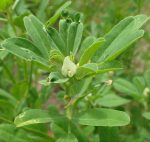
Also known as Greek hay, fenugreek is a herbaceous annual native to the Mediterranean and Middle East. It is a member of the legume family, Fabaceae, that also includes beans, lupines, and black locust. Plants grow 1-2′ tall and have single or branched stems carrying compound leaves with three oblong leaflets that are up to 2″ long and toothed. In mid summer white, pea-like flowers 1/2″ long and with hairy calyxes, appear singly or in pairs in the leaf axils. The flowers give way to curved seed pods, 2-3″ long containinig 10-20 smooth brown seeds. Photo Credit Wikipedia
The Hebrew word chatsir or chatzir appears 20 times in the Hebrew text and litterally means grass but has been variously translated as grass, herb, and hay. Some scholars think it just means greens and refers to foods like lettuce and endive. In Numbers 11:5 the word is usually translated as leek but a few scholors think that fenugreek is meant.
Numberw 11:5 (NKJV) As the Israelites wandered in the desert they complained about the lack of foods that they had eaten when living in Egypt.
“We remember the fish which we ate freely in Egypt, the cucumbers, the melons, the leeks, the onions, and the garlic;”
Fenugreek likes full sun and fertile, medium moist to dry, well-drained soil. Propagation is by seed. It is susceptible to damage by leaf spot, charcoal spot, powdery mildew, and aphids. Fenugreek dates back to 4000 BC in Iraq and was used by the ancient Egyptians in medicine, by the ancient Romans as feed for cattle and perhaps to flavor wine, while the Jews grew it as a staple food in the first century AD, and monasteries in the Middle Ages grew it in physic gardens for its multiple medicinal qualities. It has a nutty flavor and is used in the cuisines of India, Pakistani, and Africa in modern times.
The genus name, Trigonella, dates back to 4000 BC in Iraq and is from the Greek tri- meaning three, and gonia, meaning angle, and refers to the triangular appearance of the flowers. The specific epithet, foenum graecum, comes from the Latin words faenum meaning hay and gracum meaning Greek, referring to the supposed use of the plant by ancient Greeks as fodder, and providing the common name, Greek hay.
Type: Herbaceous annual
Bloom: Small white pea-like flowers singly or in pairs in leaf axils in midsummer
Size: 1-2′ H
Light: Full sun
Soil: Fertile, medium moist to dry, well-drained
Hardiness: Not hardy
Care: Low maintenance
Pests and Diseases: Leaf spot, charcoal spot, powdery mildew, aphids
Propagation: Seed; does not transplant well.